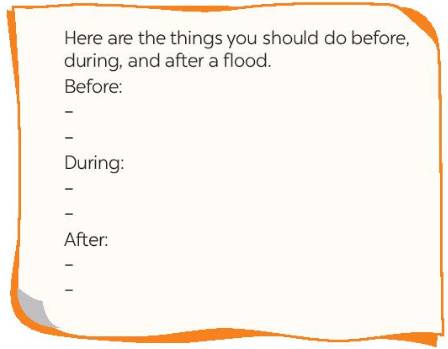Work in pairs. Look at the picture and answer the questions.

1. What can you see in the picture?
2. When do we need these things?
Work in pairs. Look at the picture and answer the questions.

1. What can you see in the picture?
2. When do we need these things?
Listen to a broadcast. Put the activities (1- 6) in the correct column.
1. Listen to instructions from local authorities.
2. Prepare an emergency kit.
3. Stay inside the house.
4. Keep away from dangerous areas.
5. Avoid windows and glass doors.
6. Strengthen houses.

Listen again and tick T (True) or F (False) for each sentence.
| T | F | |
| 1. The broadcast is on TV. | ||
| 2. You should bring flowerpots and rubbish bins into the house. | ||
| 3. Right after the storm, you can leave your home. | ||
| 4. The local authority man warn you about dangerous places. |
Work in pairs. Discuss what you should do before, during and after a flood. Write your ideas in the columns.
| Before a flood | During a flood | After a flood |
- Prepare an emergency kit. ... | - Stay inside a safe and high place. ... | - Avoid moving water. ... |
Work in pairs. Discuss what you should do before, during and after a flood. Write your ideas in the columns.
| Before a flood | During a flood | After a flood |
- Prepare an emergency kit. - Check your insurance. - Listen to local radio | - Stay inside a safe and high place. - Follow the routes specified by officials. - Time permitting, leave a note informing others when you left and where you went | - Avoid moving water. - Emergency workers will be assisting people in flooded areas. - Return home only when authorities indicate it is safe. |
Write instructions (80 - 100 words) about things to do before, during, and after a flood.
Start as follows:

Tham khảo
Here a things you should do before, during and after a flood.
Before:
+ Build an emergency kit and make a family communications plan.
+ Avoid building in a floodplain unless you elevate and reinforce your home.
+ Elevate the furnace, water heater and electric panel in your home if you live in an area that has a high flood risk.
+ Consider installing "check valves" to prevent flood water from backing up into the drains of your home.
+ If feasible, construct barriers to stop floodwater from entering the building and seal walls in basements with waterproofing compounds.
During:
+ Listen to the radio or television for information.
+ Be aware that flash flooding can occur. If there is any possibility of a flash flood, move immediately to higher ground. Do not wait for instructions to move.
+ Be aware of stream, drainage channels, canyons and other areas known to flood suddenly. Flash floods can occur in these areas with or without typical warnings such as rain clouds or heavy rain.
After:
+ Avoid moving water.
+ Stay away from damaged areas unless your assistance has been specifically requested by police, fire, or relief organization.
+ Emergency workers will be assisting people in flooded areas. You can help them by staying off the roads and out of the way.
+ Play it safe. Additional flooding or flash floods can occur. Listen for local warnings and information. If your car stalls in rapidly rising waters, get out immediately and climb to higher ground.
+ Return home only when authorities indicate it is safe.
Trả lời bởi Sunn
1. I can see an emergency kit.
2. We need these things when it has a natural disaster.
Trả lời bởi Nguyễn Việt Dũng